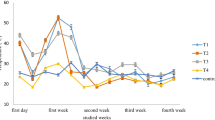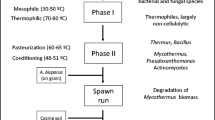Abstract
The edible mushroomAgaricus bisporus is grown commercially on composted manure/straw mixtures. However, this proven composting procedure is wasteful of raw materials. A nonmanure compost was developed (Smith, 1980) with two main aims:
-
(1)
To conserve raw materials, while still producing a compost favoringAgaricus bisporus colonization and giving an economic yield of mushrooms.
-
(2)
To speed up composting, hence making more efficient use of labor, farm equipment, and buildings.
A “conservation compost” (wheat straw, bran, whey, urea, peat, and gypsum) is ready for inoculation with mushroom mycelium (spawning) after 7 d preparation, i.e., 2 d pre-wetting of straw, then 4–5 d composting under controlled conditions. Whereas a traditional manure/wheat straw compost is produced by composting in windrows (8–11 d) followed by a controlled pasteurization phase (5–7 d).
In the preparation of a traditional mushroom compost, as much as 60% of the initial dry matter is lost by microbial degradation prior to spawning. By shortening the composting process to 7 d conservation of cellulose and hemicellulose is achieved with only some 30% loss in dry matter.
Straw hemicelluloses are degraded much quicker than cellulose during composting. Hence, the measurable extracellular laminarinase and xylanase activities of the compost microflora appear much greater than their cellulase activities at this period in both composts. A peak in laminarinase and xylanase activity after 48 h in manure compost corresponds with the increase in microbial populations.
A pronounced increase in thermophilic bacterial and actinomycete populations occurs in “conservation composts” as readily available soluble carbohydrates are assimilated. Initially, this results in higher uniform compost temperatures (60‡C+) and leads to a reduced thermophilic fungal population (103 viable propagules g-1 dry wt compost), which may explain the lowered enzyme activities found in the “conservation composts” and thus the reduced degradation of lignocellulose.
The compost microflora showed no laccase activity during composting, and little if any lignin was degraded. However,Agaricus bisporus does possess a moderately active lignolytic system and a strongly active cellulolytic system.
Subsequent experiments have shown that increased mushroom yields may be obtained from these composts when urea is replaced by chicken manure as the nitrogen supplement (Smith, 1983); this has not affected compost “selectivity” for mushroom growth, dry matter loss, or the duration of the process. Although yield of mushrooms, based on compost weights at spawning tend to be lower than what would be expected from traditional composts, yield calculated on the basis of weight of starting materials is usually much higher.
Similar content being viewed by others
References
Smith, J. F. (1980),Mushroom Sri.10 (2), 55.
Smith, J. F. (1983),Scientia Horticulturae 19, 65.
Author information
Authors and Affiliations
Rights and permissions
About this article
Cite this article
Fermor, T.R., Smith, J.F. Lignocellulose degradation in mushroom composts. Appl Biochem Biotechnol 9, 355–356 (1984). https://doi.org/10.1007/BF02798973
Issue Date:
DOI: https://doi.org/10.1007/BF02798973




